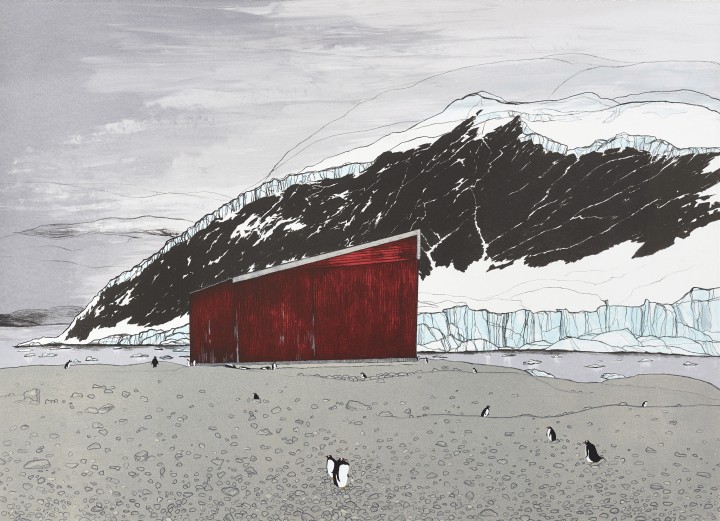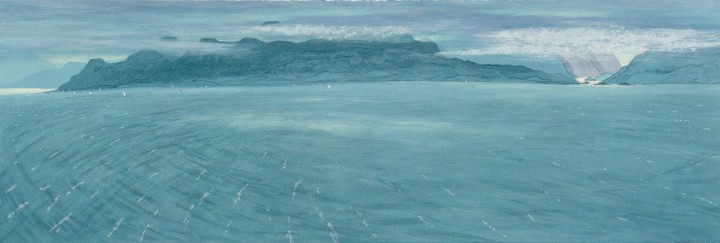Scottish Art News
Latest news
Magazine
News & Press
Publications
Frances Walker at 90
By Susan Mansfield, 02.03.2021

Among the many things that were denied us in 2020 was the opportunity to enjoy the exhibitions marking the 90th birthday of Scottish artist Frances Walker. Shows at the RSA in Edinburgh and Peacock in Aberdeen, now tentatively rescheduled for this year, would have been a chance to appreciate the work of one of Scotland’s finest living landscape painters who, despite the limits brought by age, remains focussed on making new work.
Speaking on the phone from her home in Aberdeen where she has remained alone during lockdown, she speaks with more than a hint of frustration about not being able to get to the printmaking workshop at Peacock and get on with her work. “They are bringing proofs to me here and we look at them with masks on. It’s difficult but we are getting something done, you have to collaborate.”
Walker’s clear, quick voice belies her 90 years. One suspects solitude doesn’t bother her. For much of her life she has lived and worked alone. The retrospective for her eightieth birthday at Aberdeen Art Gallery was titled ‘Place Observed in Solitude’. She doesn’t own a television or computer (“I can’t waste time trying to learn those things”); her concern is and always has been her work.
 Frances Walker RSA, Antarctic Shore Walk, 2011, screenprint, 60 x 184 cm. Ⓒ The Artist. Courtesy the RSA.
Frances Walker RSA, Antarctic Shore Walk, 2011, screenprint, 60 x 184 cm. Ⓒ The Artist. Courtesy the RSA.
If her name is not as widely known as it might be it is because she studiously avoids the spotlight. She normally declines interviews and warns me sternly more than once about the importance of accuracy. When she received the prestigious Churchill Award for art in 2015 (at the same time as Judi Dench for acting and Michael Morpurgo for literature) it was a rare moment of nationwide recognition.
Walker was born in August 1930 in Kirkcaldy. She points out that her birth coincided with the evacuation from St Kilda, when the population of Scotland’s most remote islands left their homes of their own volition to be rehoused on the mainland. Remote places have always fascinated her, especially those which were once inhabited, and she returns to them again and again in her work.
She studied at Edinburgh College of Art under William Gillies, and then trained to be a teacher at Moray House College. It was here she discovered she has synaesthesia, the neurological condition in which like words or music stimulate a person to experience colours, shapes or smells. “Today (Thursday) is greyish green, Friday is a warm brown. The colours I see tend to be softer, tweedy colours, natural colours, not Barbara-Rae strong colours."
“My own name a sort of dull pinky colour, I’ve never liked it. Your name is a pleasanter pink than mine, a lovely soft pink.” She halts herself abruptly. “But now I digress.”
Leaving college in the 1950s, she applied for a job as the sole teacher of art on Harris and North Uist. She spent half the year on each island, travelling between schools. “I went about on school buses, delivery vans, tractors, I was once on horseback. There was no electricity on North Uist all the time I was there. It came to Harris while I was there. Most people had not been to the mainland, no children had eaten ice cream, it was a time beyond a lot of people’s experience.”
 Frances Walker RSA, Tiree Window, 2017, etching, 44 x 40 cm. Ⓒ The Artist. Courtesy the RSA.
Frances Walker RSA, Tiree Window, 2017, etching, 44 x 40 cm. Ⓒ The Artist. Courtesy the RSA.
It seemed to nurture her love of remote places. She would go on to draw and paint all over the Hebrides and the Northern Isles and, from the late 1970s, would spend part of the year in a thatched cottage on Tiree. She also travelled to paint in some of the most remote places in the world: Iceland, Greenland, Canada’s North West Territories and Alaska.
Her paintings and prints often explore coastlines, rock formations and beaches. They speak of absorption in place, and examine it almost forensically, with the eye of a geographer or a geologist as well as an artist.
Often, her paintings are unpeopled, but she says the presence of human beings is often implied. “Even in the barest landscape you can often see the past. The past is there, if you look carefully, you can see the ancient lazy beds, and further back to Iron Age things, it isn’t as empty as it looks.”
In the book which accompanied the Aberdeen retrospective ten years ago, Professor Murdo MacDonald wrote: “This theme of geography and community is right at the heart of her world. She rarely draws people, and yet few artists better imply the place of human beings as part of the ecology of the planet.” In a career which has spanned seven decades, she is also capturing change, the way changing patterns of human behaviour are continually affecting the land, for good or ill.
In 1958, she was offered a job teaching drawing and painting at Gray’s School of Art in Aberdeen where she stayed until early retirement in 1985, teaching artists including Arthur Watson, Joyce Cairns, Kate Downie, Alan Robb. She was a founding member of Peacock Printmakers Workshop in 1974 (now Peacock Visual Arts and currently rebranding as Peacock & the Worm), where she taught herself etching. Recently, since surgery on a shoulder limited her ability to work on large paintings, she has been editing and remaking prints from plates she made at Peacock in the early days, revisiting landscapes from 40 years ago.
 Frances Walker RSA, Sunday Afternoon on the Sound, 2018, screenprint, 33 x 97 cm. Ⓒ The Artist. Courtesy the RSA.
Frances Walker RSA, Sunday Afternoon on the Sound, 2018, screenprint, 33 x 97 cm. Ⓒ The Artist. Courtesy the RSA.
“I’ve been finding it very interesting to do. In some places there have been big, big changes. I drew fields on Harris with little black lazybeds, fertilising the land with seaweed from the shore, all that has changed.” Tiree, meanwhile, has become a mecca for surfers from around the world. “What one of my crofting friends used to call ‘the surfacers’, as if they were gliding over the surface of life. I didn’t mind them.”
She says she has always liked “the extreme ends of the world” and has journeyed to both northern and southern extremes by boat, which she describes as “a very genuine way to travel”. In 2007, at the age of 76, she made a trip to Antarctica, after which she painted an ambitious series of large-scale paintings capturing the icy landscapes and turquoise seas. These were exhibited recently in Dundee’s McManus Galleries’ ‘Among the Polar Ice’ exhibition and are now part of the McManus collection.
“I just wanted to see it, it’s just such a different experience to go there. Things are changing there too. The historic refuge (which she painted) is no longer there. The landscape is always under threat because of the possible exploitation of all the minerals under it. Even there, everything is changing.”
The exhibition of Frances Walker at the Royal Scottish Acamedy is currently planned for 31st July to 4th September 2021. Peacock & the Worm will also be hosting a postponed series of events this year in celebration of Walker's 90th birthday. To find out more visit peacock.studio.




